Heat-Seal Ability and Fold Cracking Resistance of Kaolin-Filled Styrene-Butadiene-Based Aqueous Dispersions for Paper-Based Packaging
Abstract
:1. Introduction
2. Materials and Methods
2.1. Substrate
2.2. Commercial Coatings and Experimental Coatings Formulation
- SA-H: styrene acrylate dispersion coating with a dry solid content of 50% (on a weight basis)
- A-H: acrylate copolymer dispersion coating with a dry solid content of 39% (on a weight basis)
- SAP-H: styrene acrylate dispersion coating filled with 6% of pigment with a dry solid content of 51% (both percentages are on a weight basis)
2.3. Differential Scanning Calorimetry
2.4. Sample Preparation
2.5. Barrier Properties
2.6. Heat-Seal Ability
2.7. Blocking
2.8. Fold Cracking
2.9. Statistical Analysis
2.10. Scanning Electron Microscope (SEM)
3. Results
3.1. Sample Preparation
3.2. Differential Scanning Calorimetry
3.3. Barrier Properties
3.4. Heat-Seal Ability
- Absence of or negligible heat-seal ability, characterized by average force <1 N (Figure 3a);
- Adhesive separation occurring at the coat–coat interface, characterized by an almost linear curve in which the average force ranged 1–2.5 N (Figure 3b); a possible alternative curve was characterized by a sequence of peaks representing inhomogeneous adhesion throughout the sealed area, attributed to too little time to allow an even interdiffusion of the polymeric fraction of the coats (Figure 3c);
- Cohesive failure of the substrate, highlighting a seal and coat-substrate interfacial bond, stronger than the one keeping the paper fibers together. In general, such behavior occurred at average forces >2.5–3 N, which corresponds with previous literature [16] (Figure 3d). The curve is characterized by a peak force, beyond which the substrate fails and substrate delamination occurs [33].
3.5. Blocking
3.6. Fold Cracking
4. Discussion
5. Conclusions
Author Contributions
Funding
Institutional Review Board Statement
Informed Consent Statement
Data Availability Statement
Conflicts of Interest
Appendix A
- An air regulator with operating pressure ranging 0–1 MPa;
- 5/2-way pneumatic valve featuring a manual knob to deviate the pressure;
- MAL double action pneumatic cylinder, characterized by a diameter of 16 mm and bore of 25 mm;
- Aluminum flat sealing tool.
- Arduino Nano v3.0
- 12 V/40 W heating cartridge
- NTC 3950 100K thermistor
- 5 V Channel Relay Module Shield, capable to hold 10 A and 230 V (AC) or 30 V (DC)
- 12 V, 5 A power supply
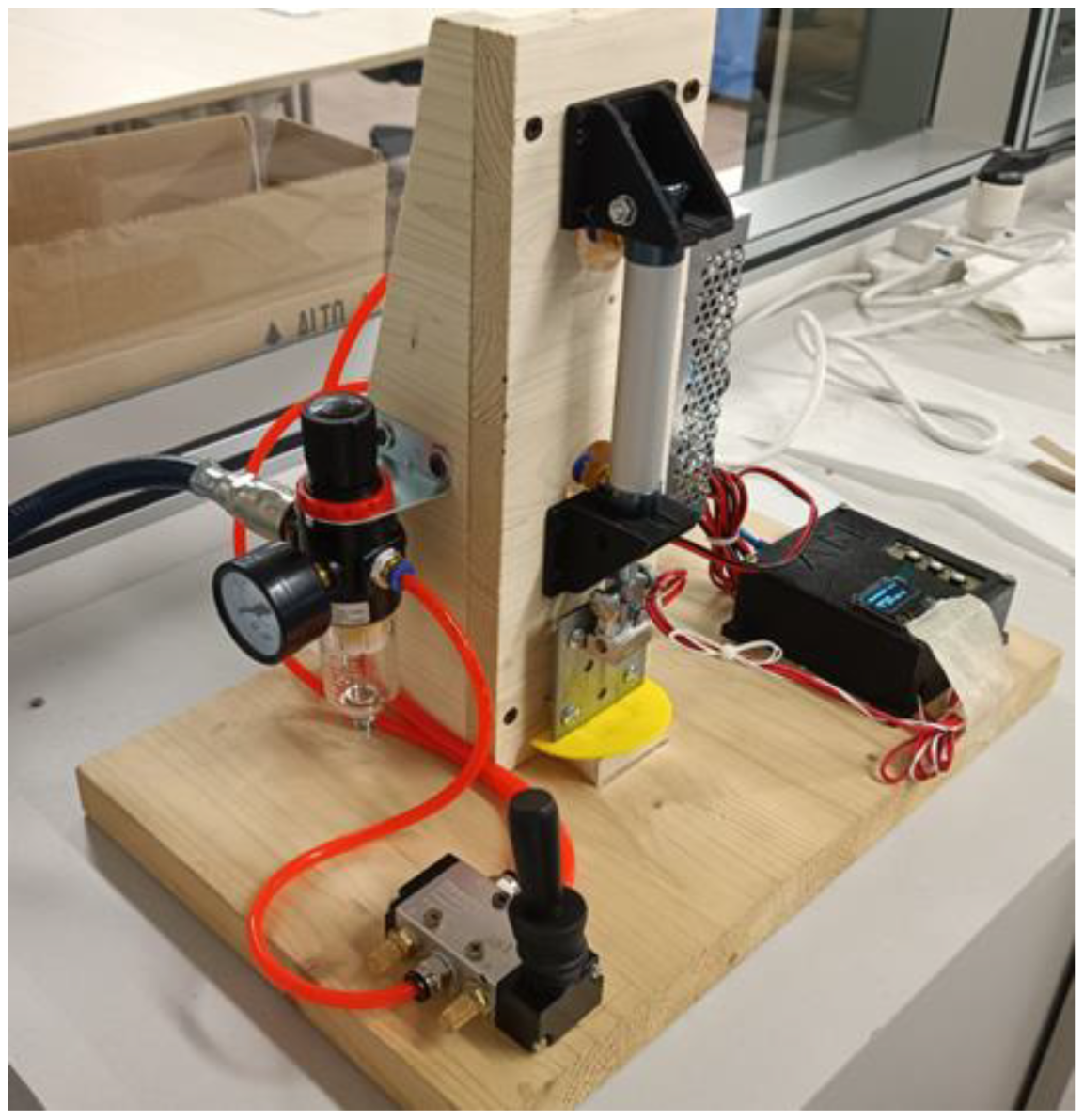
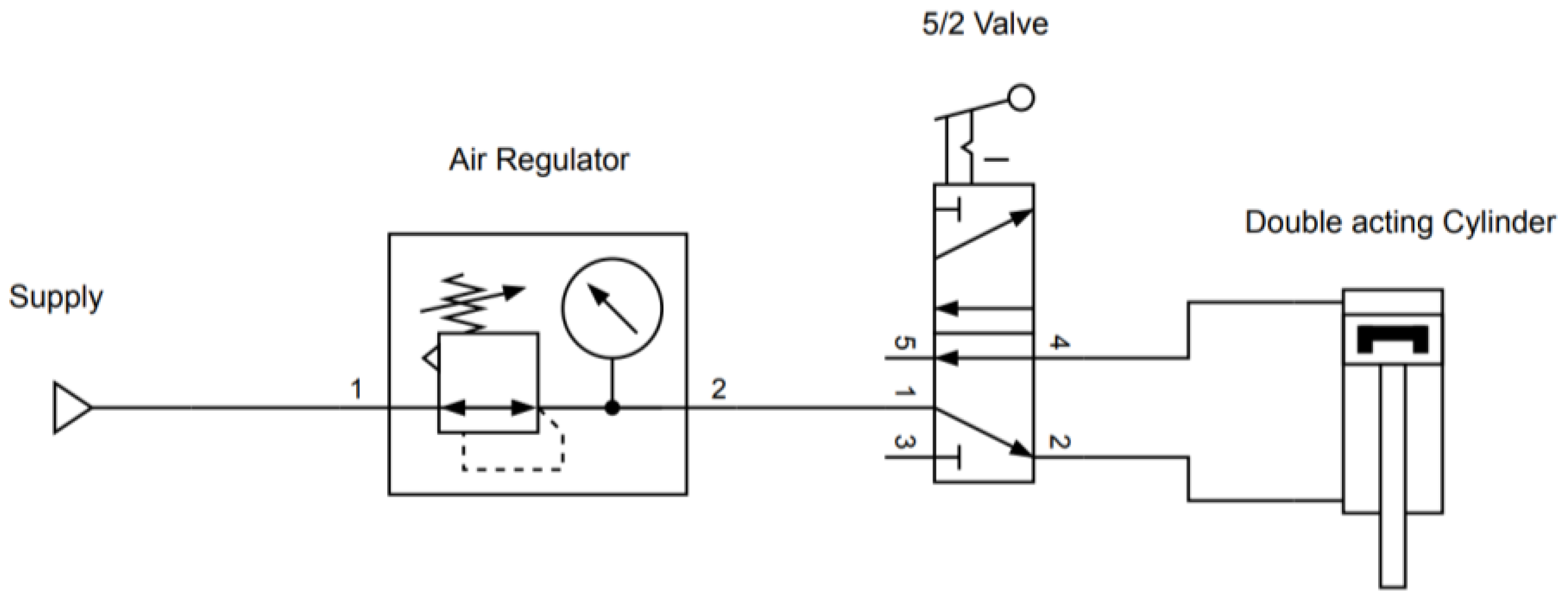
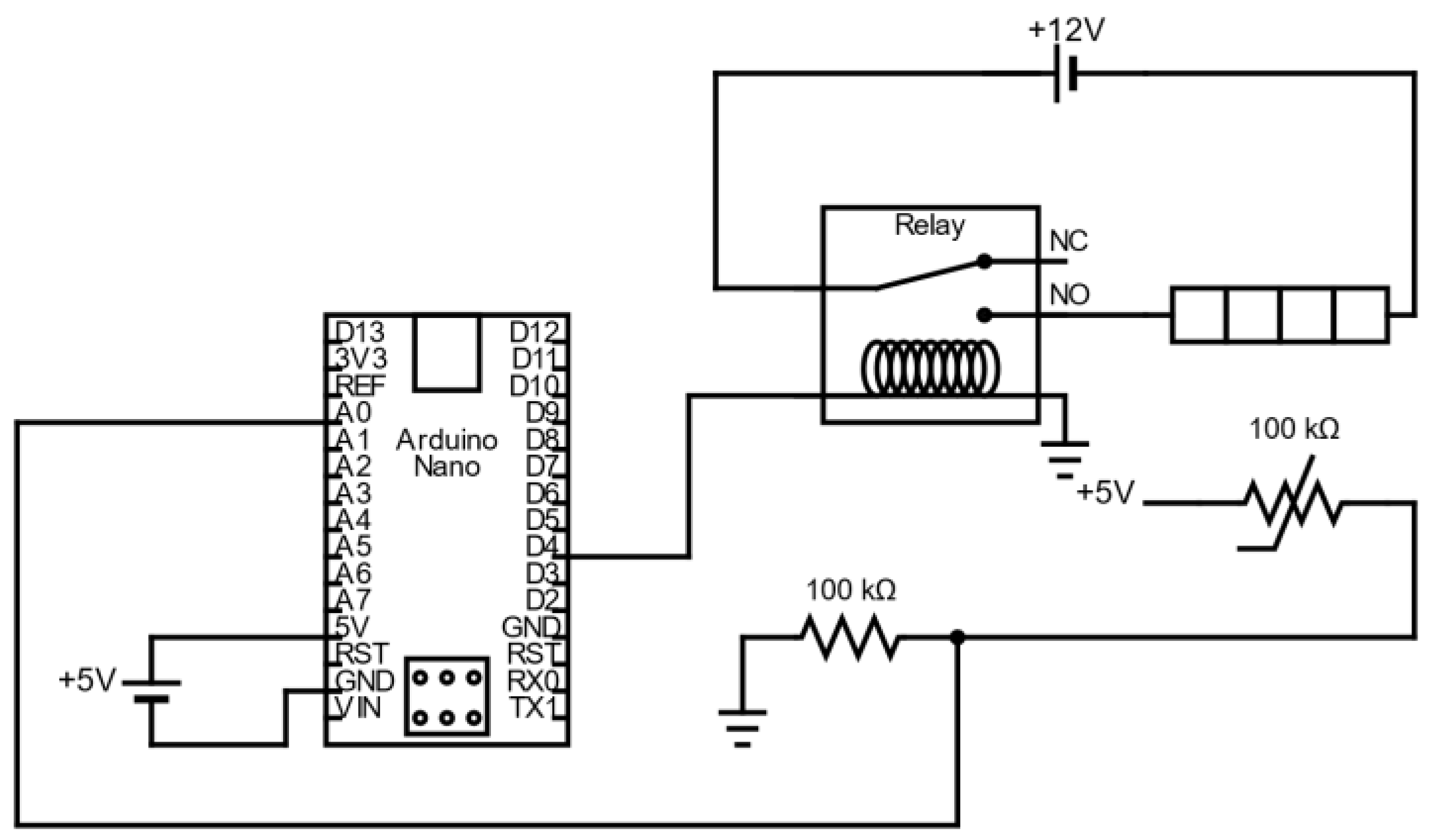
References
- Marinelli, A.; Sossini, L.; Santi, R.; Del Curto, B. Imballaggio Cellulosico con Proprietà Barriera: Stato dell’Arte e Innovazione dei Materiali, 1st ed.; Edizioni Dativo Srl: Milan, Italy, 2022; ISBN 9788894310931. [Google Scholar]
- Brander, J.; Thorn, I. Surface Application of Paper Chemicals; Blackie Academic and Professional: London, UK, 1997; ISBN 978-0-7514-0370-1. [Google Scholar]
- Keddie, J.L. Film formation of latex. Mater. Sci. Eng. R Rep. 1997, 21, 101–170. [Google Scholar] [CrossRef]
- Cepi Paper-Based Packaging Recyclability Guidelines. Available online: https://www.cepi.org/wp-content/uploads/2020/10/Cepi_recyclability-guidelines.pdf (accessed on 15 July 2020).
- CPI Design for Recyclability Guidelines. Available online: https://thecpi.org.uk/library/PDF/Public/Publications/Guidance%20Documents/CPI_guidelines_2022-WEB.pdf (accessed on 3 October 2022).
- Marinelli, A.; Santi, R.; Del Curto, B. Linee Guida per La Facilitazione delle Attività di Riciclo degli Imballaggi a Prevalenza Cellulosica, 1st ed.; CONAI: Milan, Italy, 2020; ISBN 9788894270020. [Google Scholar]
- Marinelli, A.; Diamanti, M.V.; Pedeferri, M.; Del Curto, B. Kaolin-Filled Styrene-Butadiene-Based Dispersion Coatings for Paper-Based Packaging: Effect on Water, Moisture, and Grease Barrier Properties. Coatings 2023, 13, 195. [Google Scholar] [CrossRef]
- Lyons, A.V.; Reed, G. Pigmented aqueous barrier coatings. TAPPI J. 2020, 19, 551–558. [Google Scholar] [CrossRef]
- Rissa, K.; Vähä-Nissi, M.; Lepistö, T.; Savolainen, A. Talc-Filled Water-Based Barrier Coatings. Pap. Timber 2002, 84, 1–6. [Google Scholar]
- Schuman, T.; Karlsson, A.; Larsson, J.; Wikström, M.; Rigdahl, M. Characteristics of pigment-filled polymer coatings on paperboard. Prog. Org. Coat. 2005, 54, 360–371. [Google Scholar] [CrossRef]
- Bollström, R.; Nyqvist, R.; Preston, J.; Salminen, P.; Toivakka, M. Barrier properties created by dispersion coating. TAPPI J. 2013, 12, 45–51. [Google Scholar] [CrossRef]
- Kugge, C.; Johnson, B. Improved barrier properties of double dispersion coated liner. Prog. Org. Coat. 2008, 62, 430–435. [Google Scholar] [CrossRef]
- Zou, Y.; Hsieh, J.S.; Mehnert, E.; Kokoszka, J. The effect of pigments and latices on the properties of coated paper. Colloids Surf. A Physicochem. Eng. Asp. 2007, 294, 40–45. [Google Scholar] [CrossRef]
- Niini, A.; Leminin, V.; Tanninen, P.; Varis, J.; Laukala, T. The durability of press-formed paperboard trays—Effects of sealing and drying. Bioresources 2012, 16, 236–248. [Google Scholar] [CrossRef]
- Merabtene, M.; Tanninen, P.; Varis, J.; Leminen, V. Heat sealing evaluation and runnability issues of flexible paper materials in a vertical form fill seal packaging machine. Bioresources 2022, 17, 223–242. [Google Scholar] [CrossRef]
- Hauptmann, M.; Bär, W.; Schmidtchen, L.; Bunk, N.; Abegglen, D.; Vishtal, A.; Wyser, Y. The sealing behavior of new mono-polyolefin and paper-based film laminates in the context of bag form-fill-seal machines. Packag. Technol. Sci. 2021, 34, 117–126. [Google Scholar] [CrossRef]
- Andersson, C.; Ernstsson, M.; Järnström, L. Barrier properties and heat sealability/failure mechanisms of dispersion-coated paperboard. Packag. Technol. Sci. 2002, 15, 209–224. [Google Scholar] [CrossRef]
- Kimpimäki, T.; Savolainen, A.V. Barrier Dispersion Coating of Paper and Board. In Surface Application of Paper Chemicals; Brander, J., Thron, I., Eds.; Springer: Dordrecht, The Netherlands, 1997; pp. 208–228. ISBN -978-94-010-7151-2. [Google Scholar]
- Barbier, C.; Larsson, P.-L.; Östlund, S. Numerical investigation of folding of coated papers. Compos. Struct. 2005, 67, 383–394. [Google Scholar] [CrossRef]
- Kim, C.-K.; Lim, W.-S.; Lee, Y.K. Studies on the fold-ability of coated paperboard (I): Influence of latex on fold-ability during creasing/folding coated paperboard. J. Ind. Eng. Chem. 2010, 16, 842–847. [Google Scholar] [CrossRef]
- Vähä-Nissi, M.; Savolainen, A. Filled Barrier Dispersion Coatings. In Proceedings of the Coating Conference Proceedings; TAPPI Press: Peachtree Corners, GA, USA, 1999. [Google Scholar]
- Oh, K.; Sim, K.; Bin Jeong, Y.; Youn, H.J.; Lee, H.L.; Lee, Y.M.; Yeu, S.U. Effect of coating binder on fold cracking of coated paper. Nord. Pulp Pap. Res. J. 2015, 30, 361–368. [Google Scholar] [CrossRef]
- Alam, P.; Toivakka, M.; Carlsson, R.; Salminen, P.; Sandås, S. Balancing between Fold-crack Resistance and Stiffness. J. Compos. Mater. 2009, 43, 1265–1283. [Google Scholar] [CrossRef]
- Barbier, C.; Larsson, P.-L.; Östlund, S. On the effect of high anisotropy at folding of coated papers. Compos. Struct. 2006, 72, 330–338. [Google Scholar] [CrossRef]
- Licciardello, F. Packaging, blessing in disguise. Review on its diverse contribution to food sustainability. Trends Food Sci. Technol. 2017, 65, 32–39. [Google Scholar] [CrossRef]
- BS EN ISO 535:2014. Paper and Board. Determination of Water Absorptiveness. Cobb Method. Available online: https://bsol.bsigroup.com/Bibliographic/BibliographicInfoData/000000000030259603 (accessed on 5 January 2021).
- BS ISO 2528:2017. Sheet Materials. Determination of Water Vapour Transmission Rate (WVTR). Gravimetric (Dish) Method. Available online: https://bsol.bsigroup.com/Bibliographic/BibliographicInfoData/000000000030349864 (accessed on 3 March 2022).
- BS ISO 16532-1:2008. Paper and Board. Determination of Grease Resistance. Permeability Test. Available online: https://bsol.bsigroup.com/Bibliographic/BibliographicInfoData/000000000030164327 (accessed on 2 February 2022).
- BS EN 12702:2000. Adhesives for Paper and Board, Packaging and Disposable Sanitary Products. Determination of Blocking Behaviour of Potentially Adhesive Layers. Available online: https://bsol.bsigroup.com/Bibliographic/BibliographicInfoData/000000000030019633 (accessed on 15 November 2022).
- Breskvar, K.; Ahtik, J.; Možina, K. Cracking phenomena of coatings on label papers. Cellul. Chem. Technol. 2021, 55, 289–297. [Google Scholar] [CrossRef]
- Bakker, S.; Bosveld, L.; Metselaar, G.A.; Esteves, A.C.C.; Schenning, A.P.H.J. Understanding and Improving the Oil and Water Barrier Performance of a Waterborne Coating on Paperboard. ACS Appl. Polym. Mater. 2022, 4, 6148–6155. [Google Scholar] [CrossRef] [PubMed]
- Al-Gharrawi, M.; Ollier, R.; Wang, J.; Bousfield, D.W. The influence of barrier pigments in waterborne barrier coatings on cellulose nanofiber layers. J. Coat. Technol. Res. 2021, 19, 3–14. [Google Scholar] [CrossRef]
- Ying, H.; Qi, L.; Malotky, D.; Harris, J.; Kainz, B.; Drumright, R.; Liechty, W.; Mason, J. Coatings for sustainable paper-based flexible packaging: Barrier properties and processability. TAPPI J. 2022, 28, 617–622. [Google Scholar] [CrossRef]
- Bamps, B.; Guimaraes, R.M.M.; Duijsters, G.; Hermans, D.; Vanminsel, J.; Vervoort, E.; Buntinx, M.; Peeters, R. Characterizing Mechanical, Heat Seal, and Gas Barrier Performance of Biodegradable Films to Determine Food Packaging Applications. Polymers 2022, 14, 2569. [Google Scholar] [CrossRef]
- Ilhan, I.; Klooster, R.; Gibson, I. Effects of process parameters and solid particle contaminants on the seal strength of low-density polyethylene-based flexible food packaging films. Packag. Technol. Sci. 2021, 34, 413–421. [Google Scholar] [CrossRef]
- Michot, A.; Smith, D.S.; Degot, S.; Gault, C. Thermal conductivity and specific heat of kaolinite: Evolution with thermal treatment. J. Eur. Ceram. Soc. 2008, 28, 2639–2644. [Google Scholar] [CrossRef]
- Guo, Z.; Fan, Y. Heat seal properties of polymer–aluminum–polymer composite films for application in pouch lithium-ion battery. RSC Adv. 2016, 6, 8971–8979. [Google Scholar] [CrossRef]
- Leminen, V.; Mäkelä, P.; Tanninen, P.; Varis, J. Leakproof Heat Sealing of Paperboard Trays—Effect of Sealing Pressure and Crease Geometry. Bioresources 2015, 10, 6906–6915. [Google Scholar] [CrossRef]
- Oh, K.; Seo, D.; Youn, H.J.; Lee, Y.M.; Yeu, S.U.; Lee, H.L. Effects of coating composition and folding direction on the fold cracking of coated paper. Nord. Pulp Pap. Res. J. 2016, 31, 347–353. [Google Scholar] [CrossRef]
- Wang, Q.; Ding, N. Coating factors influencing the fold cracking of coated papers. Nord. Pulp Pap. Res. J. 2020, 35, 419–431. [Google Scholar] [CrossRef]
- Zhu, Y.; Bousfield, D.; Gramlich, W.M. The influence of pigment type and loading on water vapor barrier properties of paper coatings before and after folding. Prog. Org. Coat. 2019, 132, 201–210. [Google Scholar] [CrossRef]
- Schuman, T.; Wikström, M.; Rigdahl, M. Dispersion coating with carboxylated and cross-linked styrene–butadiene latices. 1. Effect of some polymer characteristics on film properties. Prog. Org. Coat. 2004, 51, 220–227. [Google Scholar] [CrossRef]
- Gay, C.; Leibler, L. On Stickieness. Phys. Today 1999, 52, 48–52. [Google Scholar] [CrossRef]
- Hashemi Najafi, S.M.; Bousfield, D.W.; Tajvidi, M. Cracking at the fold in double layer coated paper: The influence of latex and starch composition. TAPPI J. 2019, 18, 93–99. [Google Scholar] [CrossRef]
- Youn, H.J.; Sim, K.; Oh, K.D.; Lee, H.L.; Han, C.S.; Yeu, S.U.; Lee, Y.M. Fold cracking of coated paper: The effect of pulp fiber composition and beating. Nord. Pulp Pap. Res. J. 2012, 27, 445–450. [Google Scholar] [CrossRef]
- Yang, A.; Xie, Y.; Renjung, W. From Theory to Practice: Improving the Foldcrack Resistance of Industrially Produced Triple Coated Paper. In Proceedings of the Papercon 2011, Covington, KY, USA, 1–4 May 2011; pp. 1845–1858. [Google Scholar]


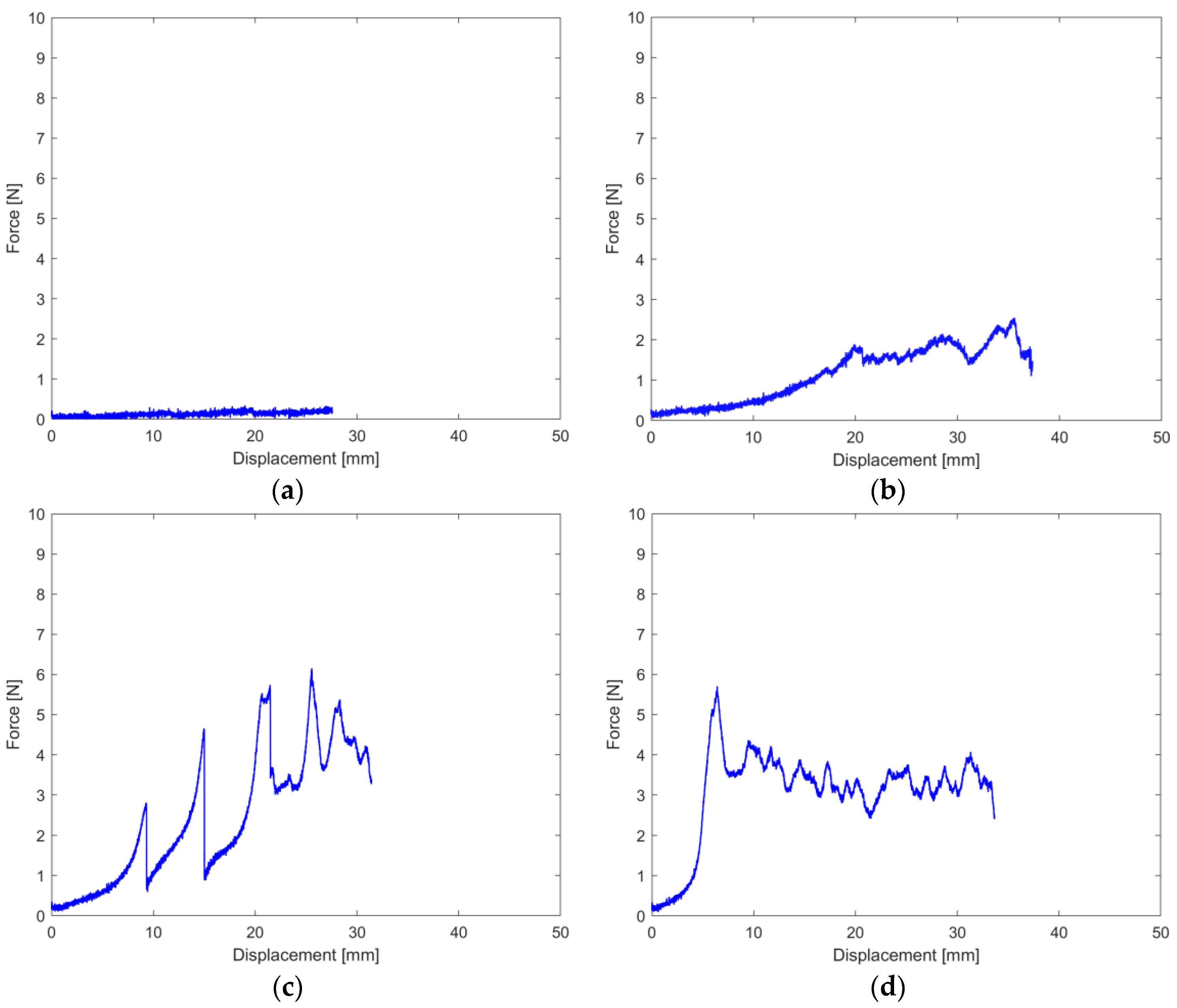
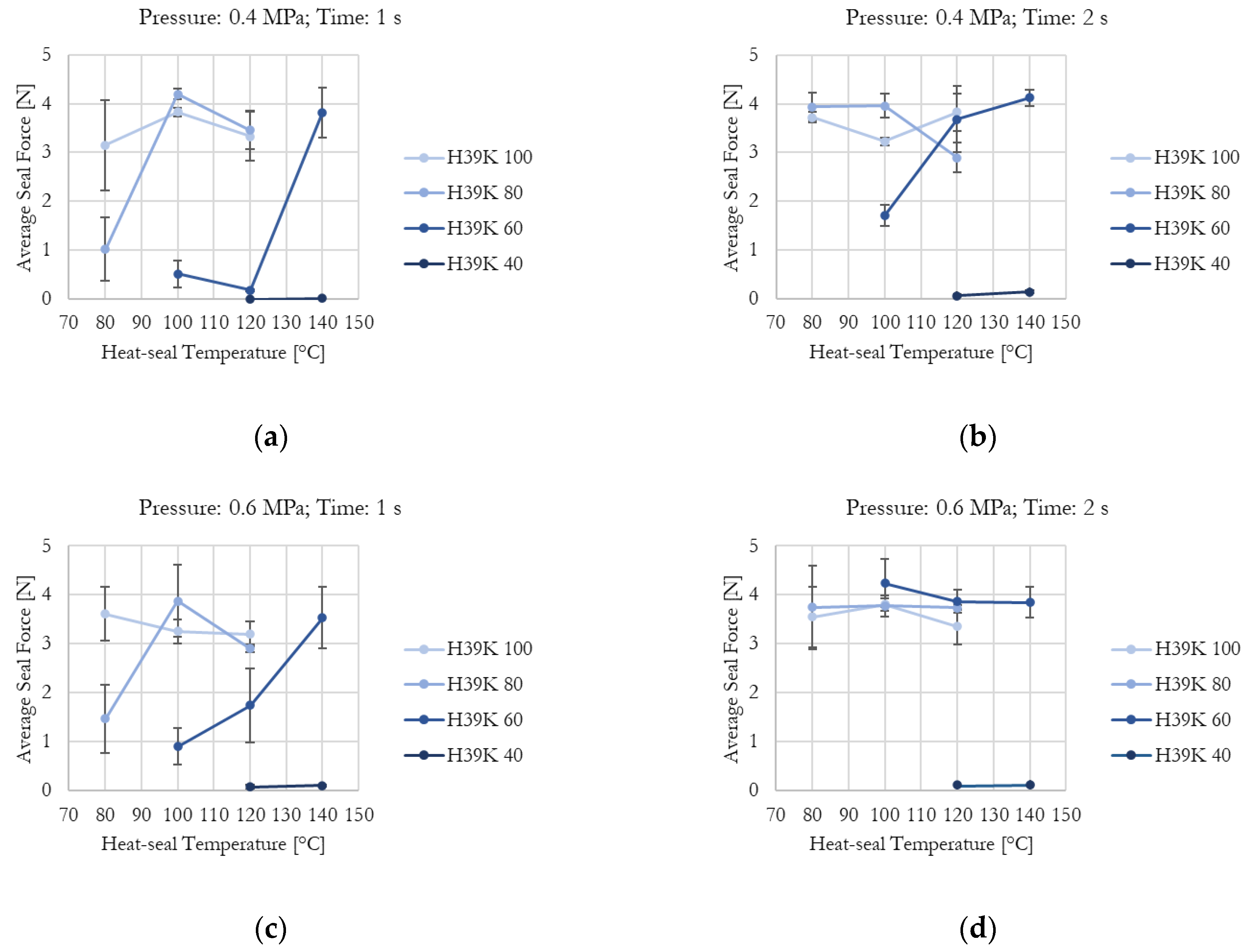
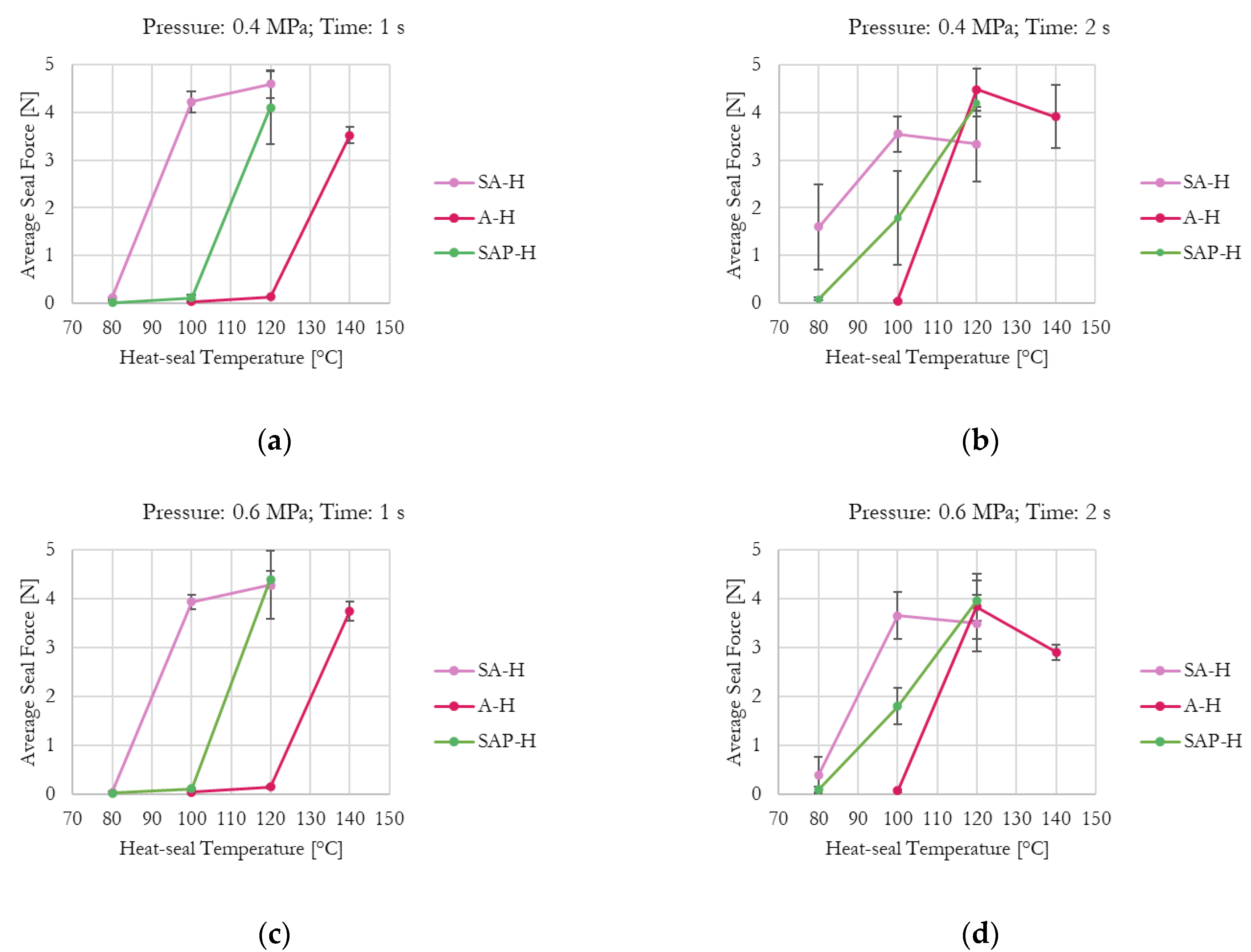
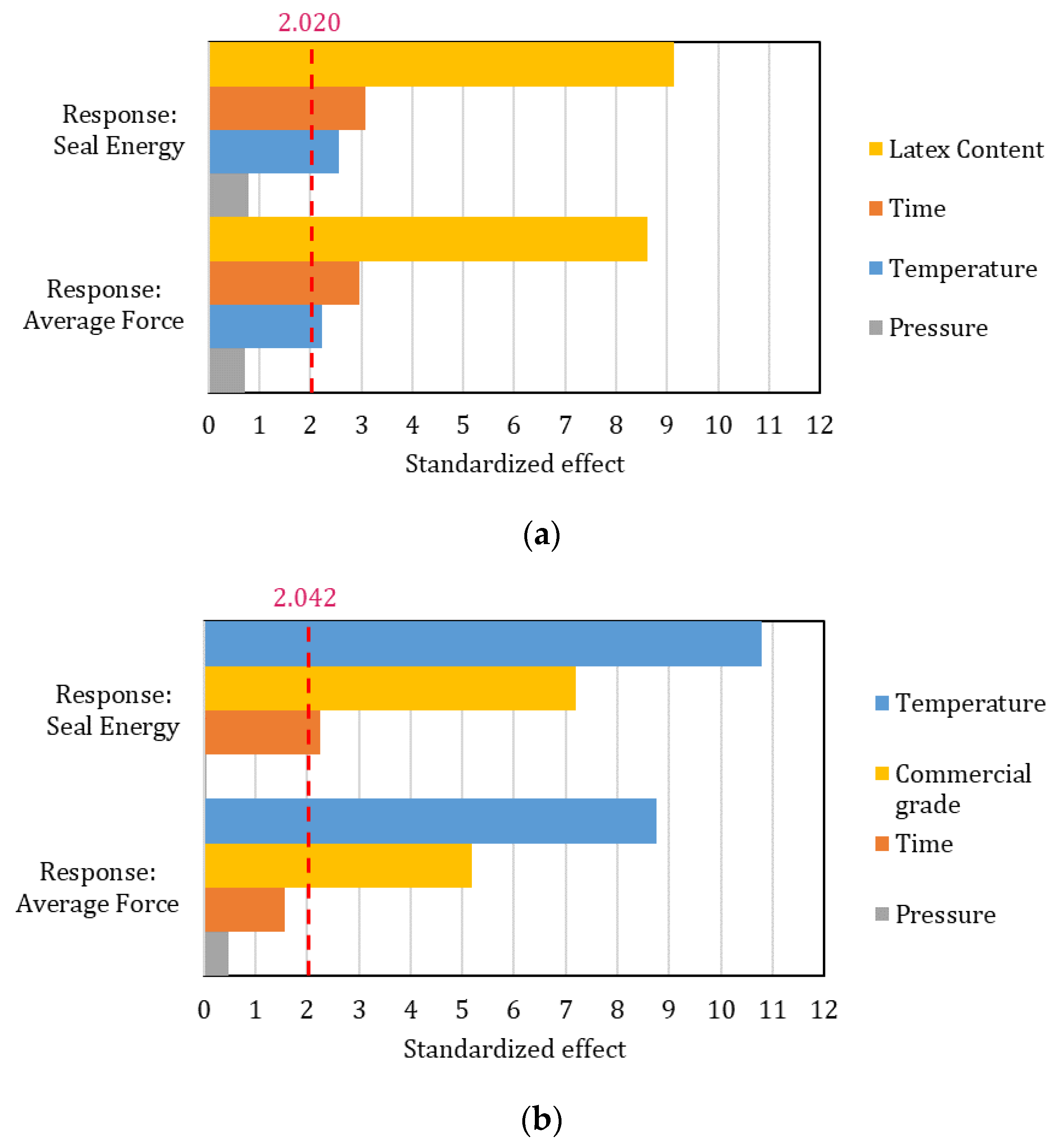
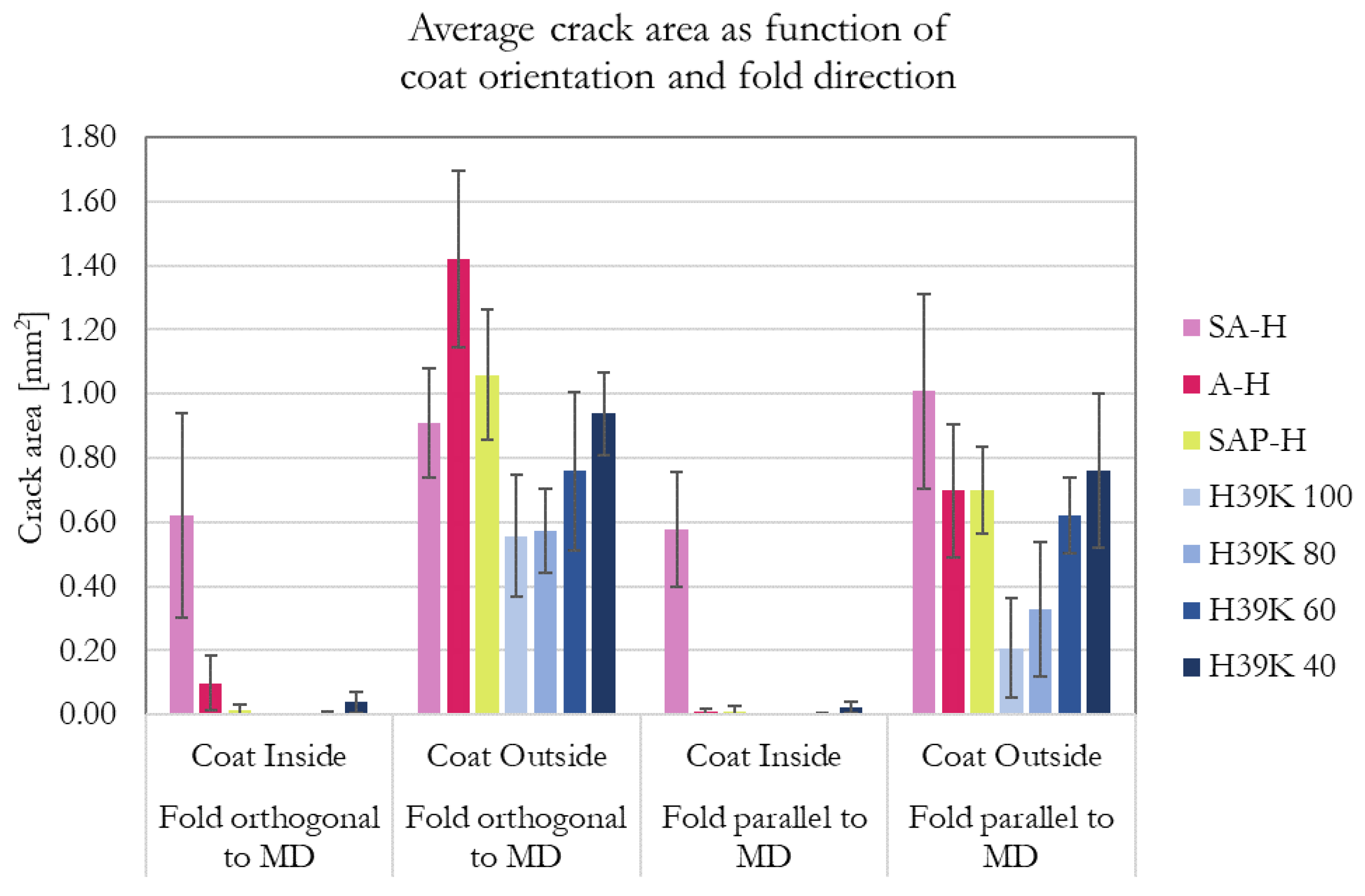
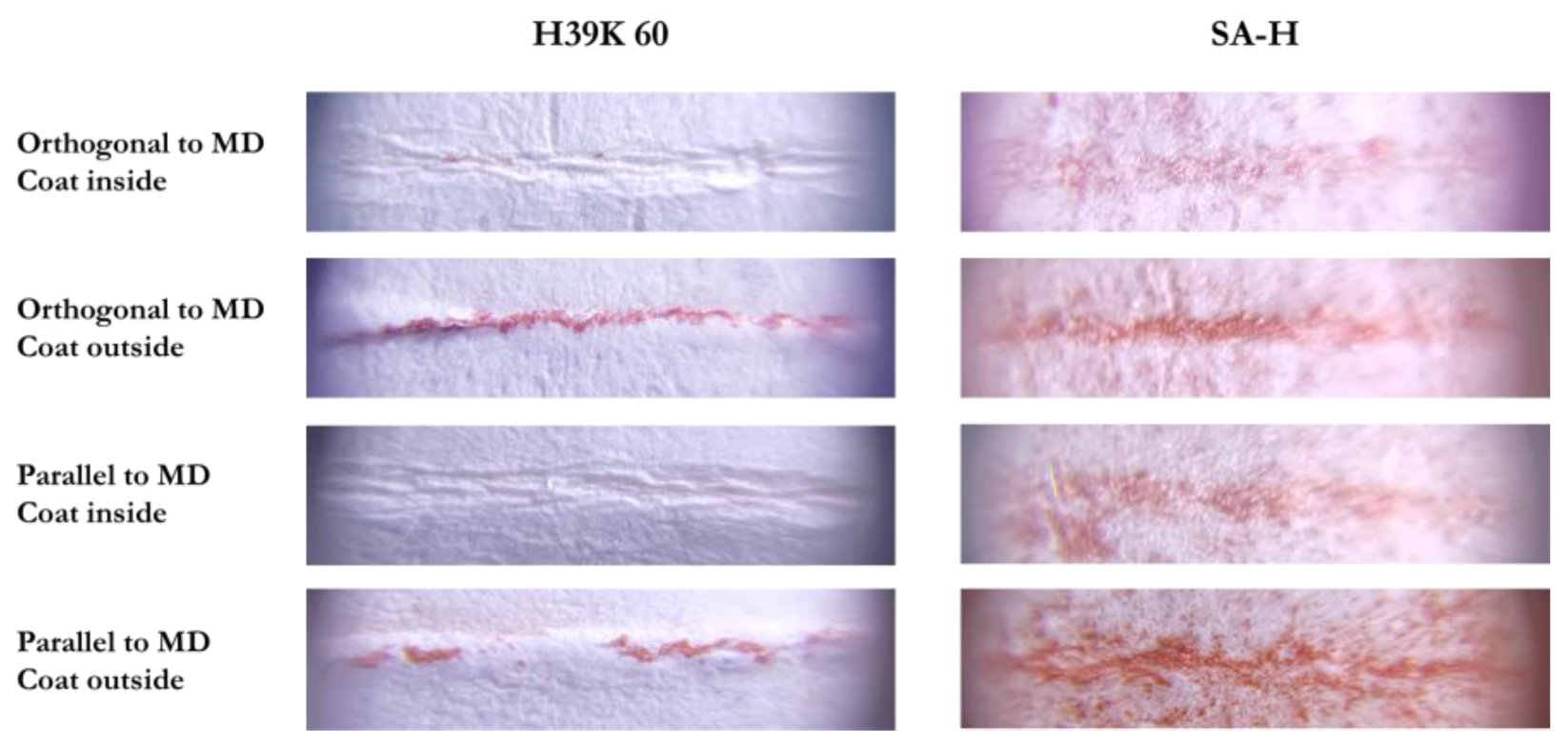
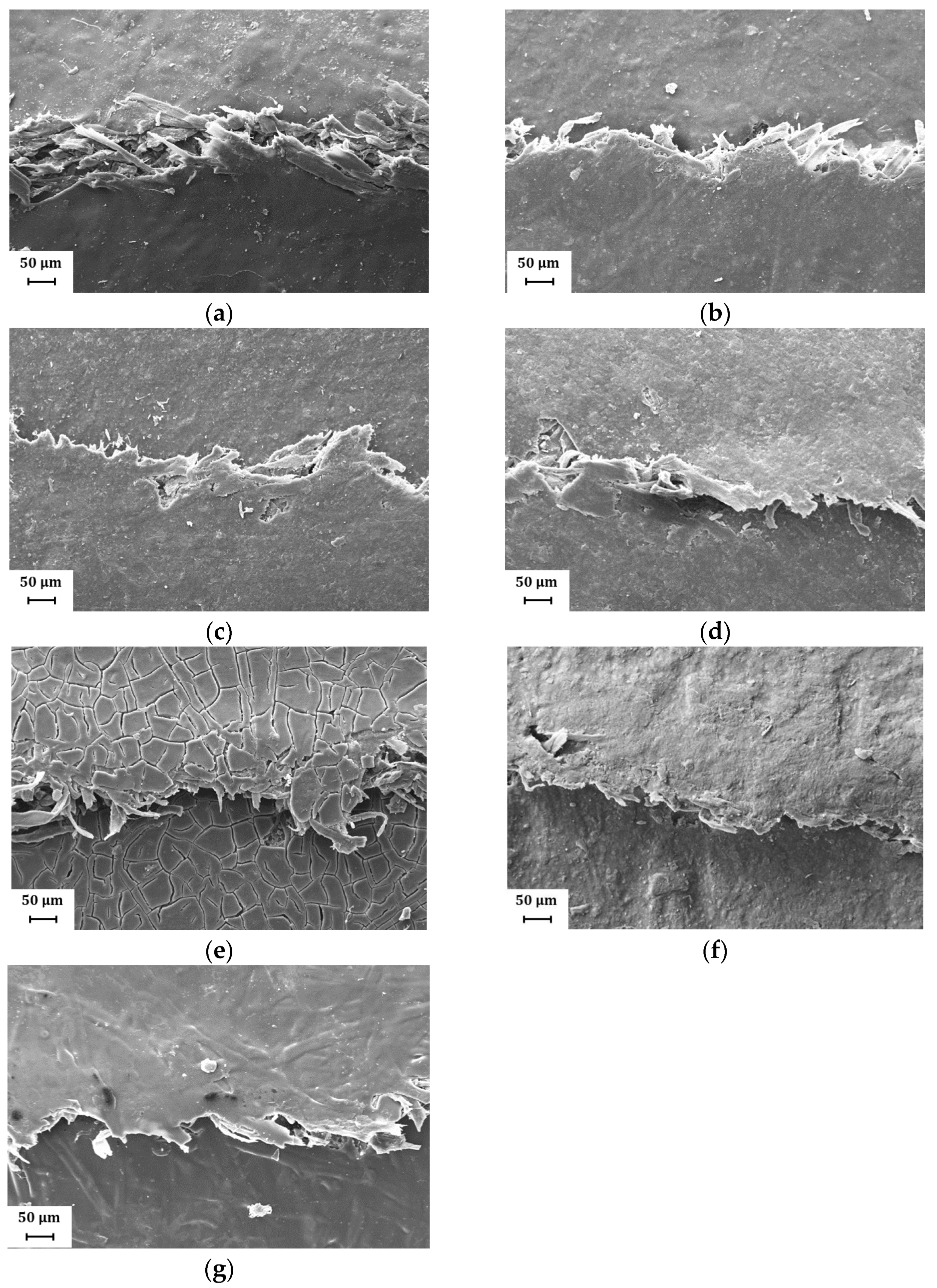
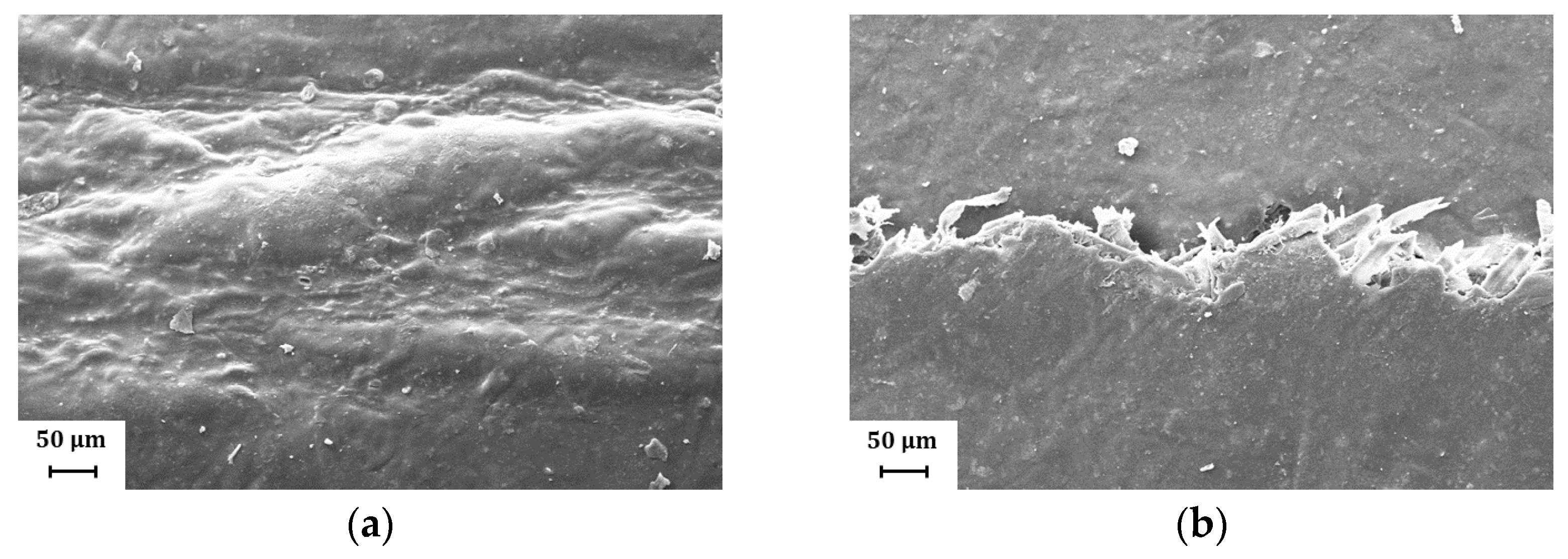
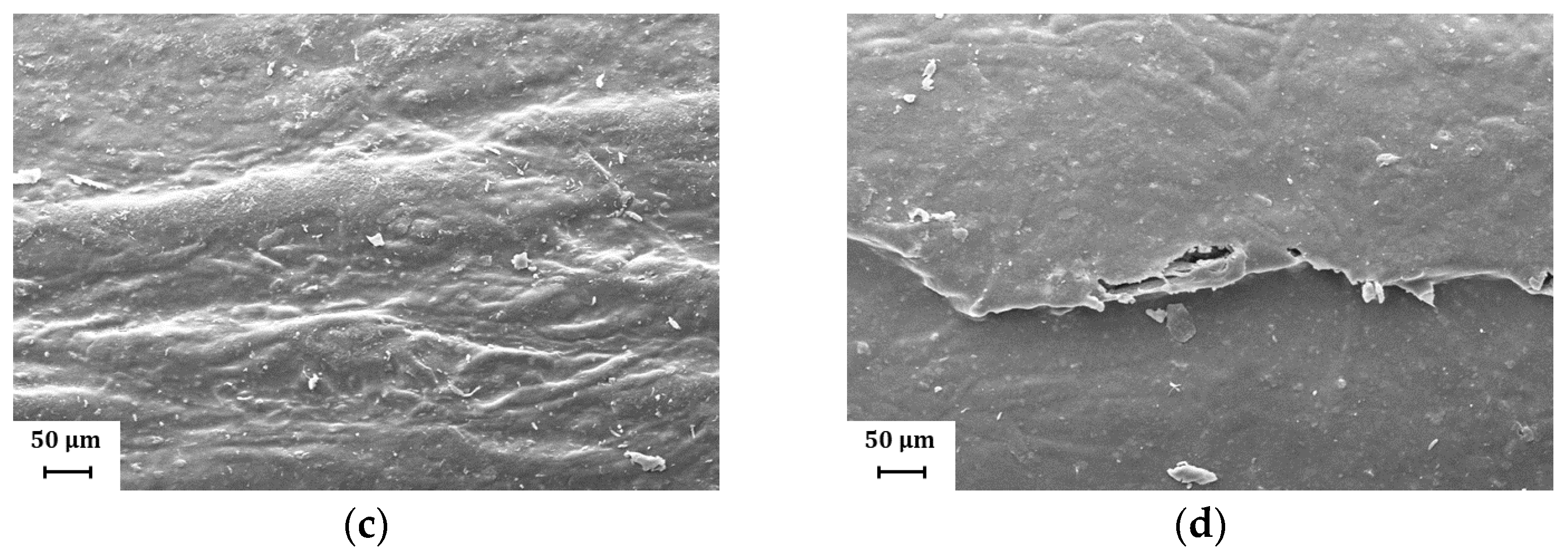

| Abbreviation 1 | Latex | Filler | Latex:Filler Ratio [%] |
|---|---|---|---|
| H39K 100 | HPH 39 | Kaolin | 100:0 |
| H39K 80 | HPH 39 | Kaolin | 80:20 |
| H39K 60 | HPH 39 | Kaolin | 60:40 |
| H39K 40 | HPH 39 | Kaolin | 40:60 |
| Parameter | Unit | Values |
|---|---|---|
| Temperature | °C | 80, 100, 120, 140 |
| Time | s | 1, 2 |
| Pressure | MPa | 0.4, 0.6 |
| Coating | Dry Coat Grammage [g/m2] | Coat Thickness [μm] |
|---|---|---|
| H39K 100 | 9.2 (1.6) | 8.9 (1.5) |
| H39K 80 | 8.0 (1.3) | 5.9 (1.0) |
| H39K 60 | 7.7 (2.0) | 4.6 (1.2) |
| H39K 40 | 9.1 (1.5) | 4.6 (0.8) |
| SA-H | 7.5 (2.6) | 7.2 (2.5) |
| A-H | 4.7 (1.5) | 4.5 (1.6) |
| SAP-H | 9.2 (2.0) | 8.8 (2.0) |
| Coating | Tg_1 [°C] | Tg_2 [°C] |
|---|---|---|
| H39K 100 | −0.6 | 19.0 |
| H39K 80 | 0.9 | 35.3 |
| H39K 60 | 2.8 | 33.3 |
| H39K 40 | 4.6 | |
| SA-H | −6.1 | 39.1 |
| A-H | 47.1 | 75.2 |
| SAP-H | 12.1 |
| Heat-Seal Energy [mJ] | |||||||||||||||||
|---|---|---|---|---|---|---|---|---|---|---|---|---|---|---|---|---|---|
| Coat | T [°C] | 80 | 100 | 120 | 140 | ||||||||||||
| t [s] | 1 | 2 | 1 | 2 | 1 | 2 | 1 | 2 | |||||||||
| P [MPa] | 0.4 | 0.6 | 0.4 | 0.6 | 0.4 | 0.6 | 0.4 | 0.6 | 0.4 | 0.6 | 0.4 | 0.6 | 0.4 | 0.6 | 0.4 | 0.6 | |
| H39K 100 | 94 (31) | 108 (20) | 111 (6) | 107 (18) | 116 (3) | 98 (5) | 99 (4) | 114 (5) | 103 (14) | 98 (7) | 113 (13) | 103 (6) | - | - | - | - | |
| H39K 80 | 29 (20) | 44 (22) | 110 (14) | 109 (20) | 119 (5) | 113 (20) | 113 (3) | 113 (10) | 101 (6) | 90 (9) | 88 (3) | 112 (2) | - | - | - | - | |
| H39K 60 | - | - | - | - | 16 (10) | 25 (10) | 35 (10) | 81 (17) | 8 (6) | 20 (20) | 102 (20) | 107 (8) | 111 (11) | 103 (16) | 115 (6) | 113 (12) | |
| H39K 40 | - | - | - | - | - | - | - | - | - | <1 | <1 | <1 | 2 (1) | <1 | 2 (2) | 3 (1) | |
| SA-H | 1 (1) | 1 (1) | 41 (30) | 8 (8) | 100 (28) | 104 (6) | 98 (10) | 109 (17) | 132 (7) | 123 (17) | 101 (22) | 105 (17) | - | - | - | - | |
| A-H | - | - | - | - | <1 | <1 | 2 (1) | 3 (2) | 9 (3) | 11 (1) | 84 (15) | 92 (8) | 74 (4) | 96 (12) | 108 (19) | 83 (5) | |
| SAP-H | <1 | 1 (1) | 3 (2) | 11 (5) | 3 (2) | 5 (1) | 54 (35) | 46 (12) | 108 (21) | 112 (7) | 121 (3) | 117 (10) | - | - | - | - | |
| Blocking Level | |||
|---|---|---|---|
| Coating | 40 °C | 60 °C | 80 °C |
| SA-H | 0 * | 0 * | 0 * |
| A-H | 0 | 0 | 0 * |
| SAP-H | 0 * | 0 * | 0 * |
| H39K 100 | 1 | 1 | 1 |
| H39K 80 | 0 * | 0 * | 0 * |
| H39K 60 | 0 | 0 | 0 |
| H39K 40 | 0 | 0 | 0 |
| Folding Set of Conditions | ||||
|---|---|---|---|---|
| Coating | Orth. to MD Coat Inside | Orth. to MD Coat Outside | Par. to MD Coat Inside | Par. to MD Coat Outside |
| H39K 40 | A | A | A | A |
| H39K 60 | B | A, B | B | A |
| H39K 80 | B | B, C | B | B |
| H39K 100 | B | C | B | B |
Disclaimer/Publisher’s Note: The statements, opinions and data contained in all publications are solely those of the individual author(s) and contributor(s) and not of MDPI and/or the editor(s). MDPI and/or the editor(s) disclaim responsibility for any injury to people or property resulting from any ideas, methods, instructions or products referred to in the content. |
© 2023 by the authors. Licensee MDPI, Basel, Switzerland. This article is an open access article distributed under the terms and conditions of the Creative Commons Attribution (CC BY) license (https://creativecommons.org/licenses/by/4.0/).
Share and Cite
Marinelli, A.; Profaizer, M.; Diamanti, M.V.; Pedeferri, M.; Del Curto, B. Heat-Seal Ability and Fold Cracking Resistance of Kaolin-Filled Styrene-Butadiene-Based Aqueous Dispersions for Paper-Based Packaging. Coatings 2023, 13, 975. https://doi.org/10.3390/coatings13060975
Marinelli A, Profaizer M, Diamanti MV, Pedeferri M, Del Curto B. Heat-Seal Ability and Fold Cracking Resistance of Kaolin-Filled Styrene-Butadiene-Based Aqueous Dispersions for Paper-Based Packaging. Coatings. 2023; 13(6):975. https://doi.org/10.3390/coatings13060975
Chicago/Turabian StyleMarinelli, Andrea, Mauro Profaizer, Maria Vittoria Diamanti, MariaPia Pedeferri, and Barbara Del Curto. 2023. "Heat-Seal Ability and Fold Cracking Resistance of Kaolin-Filled Styrene-Butadiene-Based Aqueous Dispersions for Paper-Based Packaging" Coatings 13, no. 6: 975. https://doi.org/10.3390/coatings13060975
APA StyleMarinelli, A., Profaizer, M., Diamanti, M. V., Pedeferri, M., & Del Curto, B. (2023). Heat-Seal Ability and Fold Cracking Resistance of Kaolin-Filled Styrene-Butadiene-Based Aqueous Dispersions for Paper-Based Packaging. Coatings, 13(6), 975. https://doi.org/10.3390/coatings13060975









